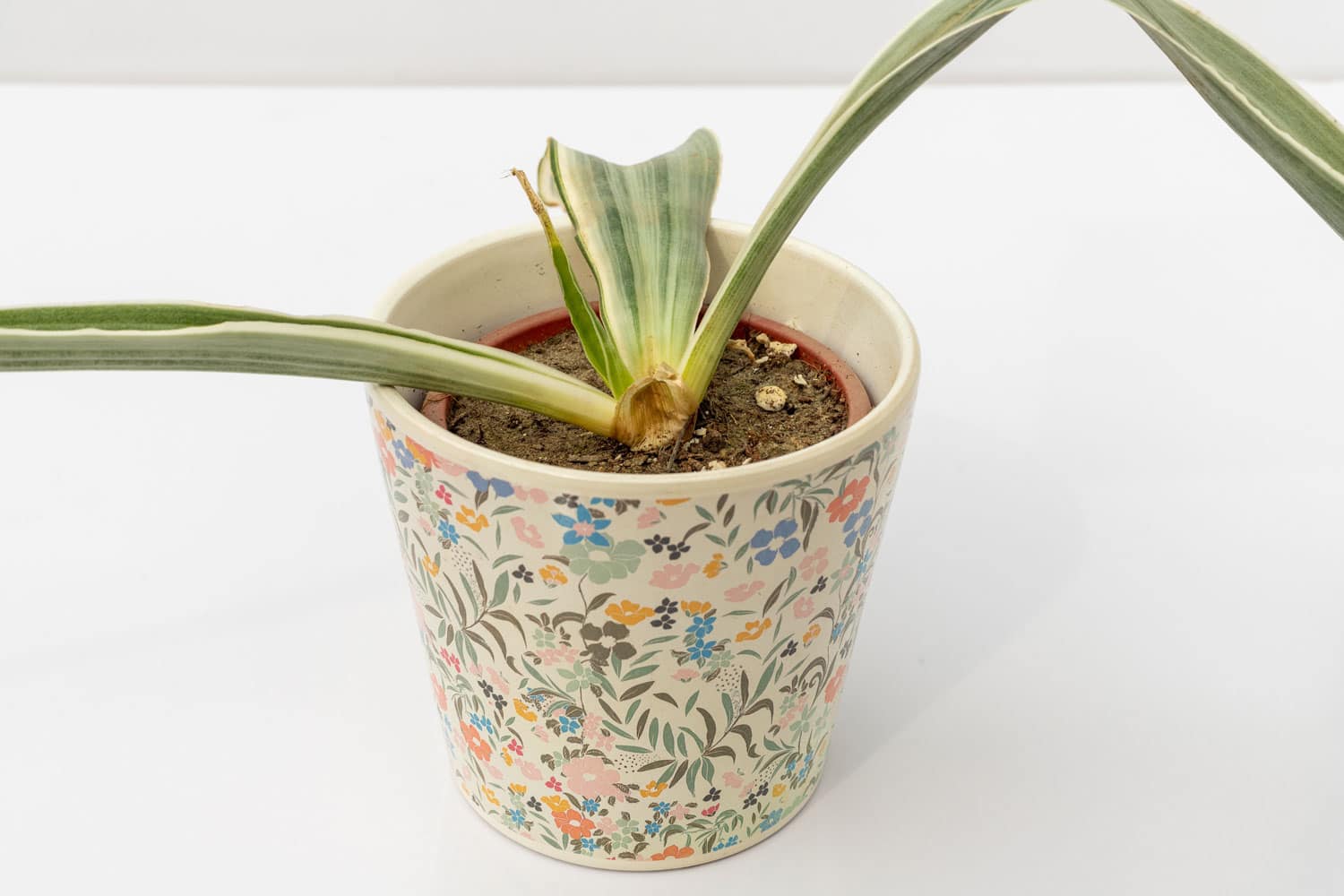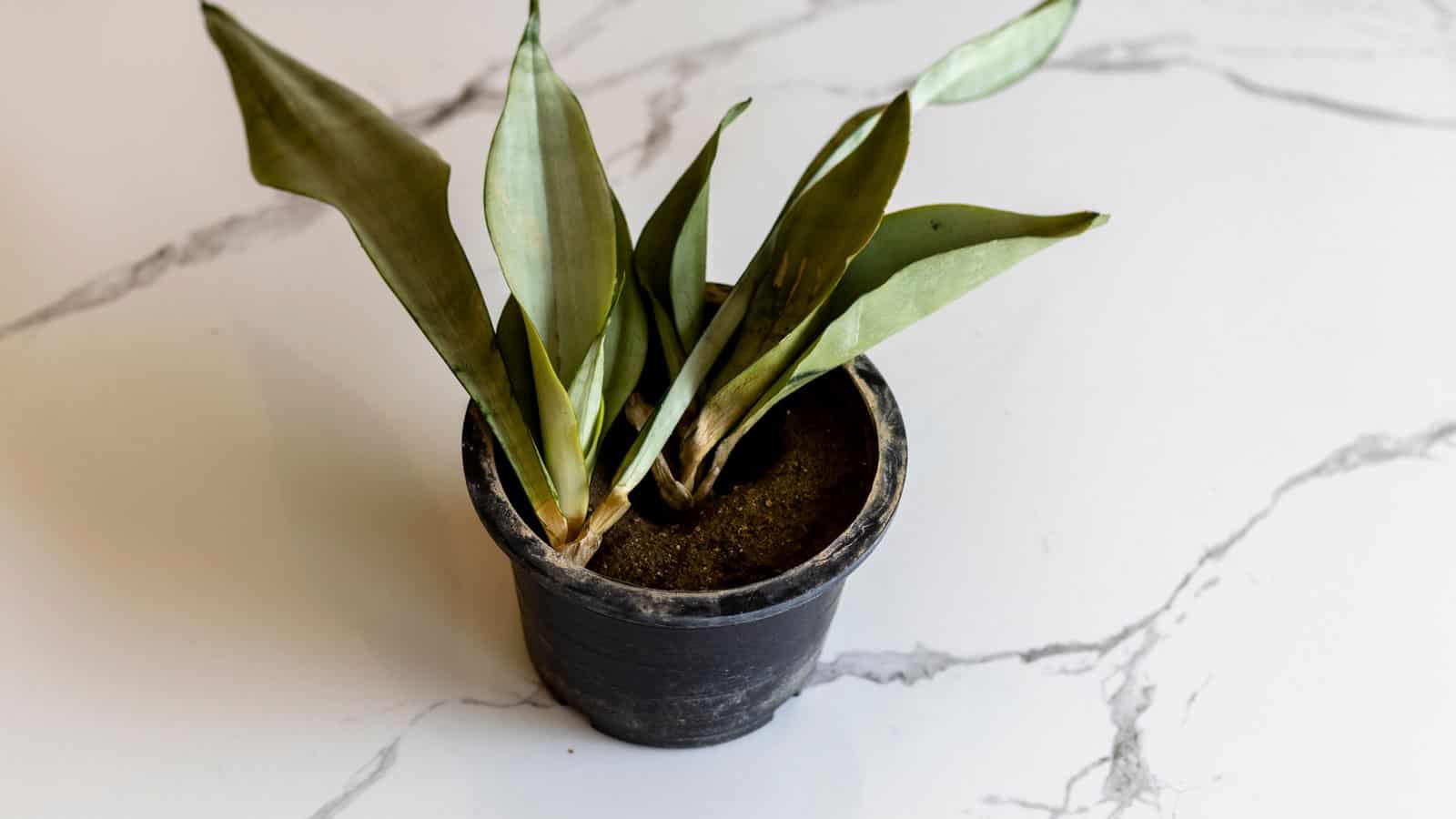Snake plants are generally low-maintenance and do not typically produce a strong scent, so a bad smell could indicate an underlying issue.
If you've noticed an unpleasant odor coming from your snake plant, it's important to identify the source in order to address the problem effectively.

Here, we'll discuss the factors contributing to the funky smell in your snake plant and provide tips to rectify the problem and maintain a healthy plant.
Common Causes for Funky Smells
Taking note of these common causes and addressing them appropriately can help maintain the health of your snake plant and eliminate any unpleasant odors.
Root rot
One of the main reasons for a nasty smell from your snake plant may be due to root rot caused by overwatering.
Root rot can produce a sewage-like smell, and this issue may be detected by examining your plant's roots for a slimy or blackened appearance.

Look for a foul smell from the soil or brown tips on the leaves, which are indicative of root rot.
Key symptoms may also include soft and jelly-like leaves, dark and soft spots near the plant's base, wilting or drooping leaves, and brown or black mushy roots.
Potting Mix Issues
Another potential cause for an unpleasant smell is the potting mix used for the snake plant.
Low-quality potting mixes may not provide adequate drainage or hold water for too long, leading to root rot.
Pest Infestation
Various pests, such as fungus gnats, can be attracted to wet soil and may contribute to the funky smell in your snake plant.
These pests lay their eggs in the soil, and upon hatching, the larvae primarily feed on fungi, algae, and decaying plant matter in the moist soil.
While the larvae can also feed on the plant roots, they are more likely to do so if the plant is already experiencing issues such as rotting roots or decaying organic matter in the soil.
In severe infestations, where the larvae feed extensively on the plant roots, it may exacerbate root rot, potentially contributing to a decayed or unpleasant smell from the rotting plant material.
Poor Ventilation
Lastly, poor ventilation around your snake plant may contribute to a funky smell.
Good airflow is necessary to prevent moisture buildup, which can lead to problems like mold, mildew, and root rot.
Quick Fixes for Funky Smells
Worried about unexpected aromas from your cherished snake plant? Let’s explore the quick fixes to keep your plant fresh and thriving.
Changing Potting Mix
A stale or contaminated potting mix can also cause unpleasant odors from your snake plant.
To fix this problem, remove the plant from its current pot and gently shake off any loose soil.
Replace the old potting mix with a fresh, well-draining mixture, then replant your snake plant.
This will help eliminate any buildup of bacteria or fungi that may be contributing to the smell.
A well-draining soil mix will help the plant roots absorb water and nutrients more effectively.
Consider replacing the current potting mix with a blend of equal parts peat moss, perlite, and potting soil.
This combination promotes better drainage and reduces the likelihood of root rot.
Treating Infestations
Inspect your plant for signs of pests such as mealybugs, spider mites, or scales.
If you spot any, treat the plant with an appropriate pesticide or insecticidal soap.
Moreover, keep an eye on the plant's health and take steps to remove any damaged leaves or parts to prevent further issues.
Regularly check your plant for any signs of reinfestation and repeat the treatment if necessary.
Improving Ventilation
Make sure your plant is positioned in a well-ventilated area and avoid crowding it with other plants.
This will help to dissipate any unpleasant odors and promote the overall health of your snake plant.
Consider placing a small fan nearby to help improve air circulation around the plant.
Additionally, to prevent future mold growth, monitor and adjust the humidity levels around your plant.
Mold and mildew thrive in damp, humid environments, so it's important to keep your plant's soil from staying too moist for extended periods.
If you notice a musty smell and see visible signs of mold on the soil surface, repot your plant using fresh soil.
Addressing Root Rot in Snake Plants
To treat root rot in your snake plant, follow these steps. We've divided them based on the severity of the root rot:
If the rot is severe affecting both roots and stems:
- Trim away the rotted areas making a clean cut about 1 cm above the rotted area using a sharp pair of scissors.
- Apply cinnamon powder on the cut areas to prevent fungal growth.
- Allow some time for the wound to heal, a small callus will form on the cut if not treated.
- Once healed, plant it in a new substrate. This way, a new seedling will be propagated and the succulents will sprout again.
If the root rot is not severe or restricted only to roots:
- Water the plant and the soil around it to ease the removal of the plant from its pot.
- Carefully remove your snake plant from its old pot, inspect the roots for signs of rot, and trim away any infected roots.
- Treat the cut roots with a fungicide solution to eliminate any remaining fungus spores.
- Select a pot that is large enough to accommodate the plant’s growth, but not too large to prevent water accumulation.
In the repotting process, cover the drainage holes with a porous material like coffee filter paper to allow successful water drainage, fill it with fresh succulent soil, and place the plant inside.
It's essential to look for roots that are squishy, slimy, discolored, or giving off a foul odor, and trim them off with disinfected scissors, then replant your snake plant in a clean pot with fresh potting mix.
Once identified, make sure to choose a pot that's only 1–2 inches larger than necessary, as oversized pots can contribute to root rot due to excess moisture sitting in the soil.
You might also like to read: Overwatering Crisis: Saving Your Snake Plant from Root Rot
Preventive Measures
By implementing these friendly and straightforward preventive measures, you can better protect your snake plant from developing funky smells or unhealthy growth.
Regular Plant Check-up
By closely observing your plant's leaves and overall condition, you can easily identify any unusual markings, smells, or signs of disease before they become a serious problem.
If you happen to notice any funky smells or other issues, you can address them quickly to prevent further damage to your beloved houseplant.
Appropriate Watering
The snake plant prefers to be watered when the top half of the soil is dry.
To determine this, simply insert your finger a few inches into the soil to feel the moisture level.
When watering your snake plant, give it only a splash of water because it is native to heat and drought conditions.
Give your snake plant just enough water to keep the soil slightly moist but not soggy.
To find the perfect balance, monitor your snake plant's soil moisture levels and adjust your watering habits accordingly.
Stick to a watering schedule once every 10–14 days, and reduce watering frequency during the dormant winter months.
Also, make sure your pot and soil allow for sufficient drainage to prevent waterlogging.
To learn more, check out this article: How Often To Water Your Snake Plant
Keeping Clean Surroundings
Maintaining a clean environment around your snake plant contributes to its well-being.
Remove any debris, fallen leaves, or dead parts of the plant regularly. This will not only help to deter pests and fungal infections but will also make your plant more aesthetically pleasing.
Also, consider placing your snake plant away from mold-prone areas, as mold can contribute to foul odors.
In Closing
Detecting an odd scent from your cherished snake plant can be concerning. By pinpointing the cause, be it root rot from overwatering or other culprits like pests or diseases, you're well on your way to a solution.
Snake plants, known for their resilience, thrive with minimal water.
So, if the aroma lingers post moisture adjustments, check for pests or diseases.
Regular inspections and creating the right environment can fend off future issues.
In the world of plant care, attentiveness is your best tool. Tune into your snake plant's signals, and you'll keep it flourishing.

